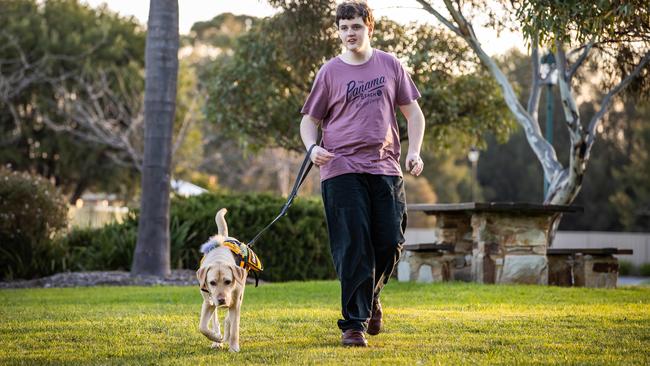How two assistance dogs, River and Ringer, changed an autistic boy’s life
Billy is 17, autistic and non-verbal. This is the story of how two dogs, Ringer and River, changed his life – giving other families of kids with a disability hope for the future.
SA Weekend
Don't miss out on the headlines from SA Weekend. Followed categories will be added to My News.
Billy leans across the kitchen table and types carefully into his iPad. He is answering the question: How does Ringer help you?
Ringer being his assistance dog, a bustling two-year-old golden labrador who is hovering in the far corner, wondering what all the fuss is about.
“I love my dog Ringer,” he writes.
“He loves me. He not judge.”
Billy is 17, autistic and non-verbal. He also suffers from epileptic seizures and a disorder called Pica, which means he eats non-food objects. This has led him to a number of extended stays in hospital (and a house remarkably free of inanimate objects).
When he was young, he was “a runner”, a common term used by parents of autistic children, where the child simply takes off without warning, regardless of the surrounds or associated risks.
“It wasn’t easy,” Tania says with a smile and slight shake of her head. At her wit’s end, she sought help and was finally able to secure him an autism assistance dog. That was 10years ago.
His name is River and, having just ticked over 11 years of age, he’s recently “retired” and lying asleep, snoring quietly, on a cushion next to the kitchen table in Tania’s north east home.
Earlier this year, Ringer came on to the scene to pick up the mantle.
The impact of the two pooches on the lives of Billy, Tania and daughter Laura, 13, is stunning.
“It’s been life changing,” Tania says simply.
Billy’s not visually impaired but there was only one place Tania could find the help she needed: Guide Dogs SA/NT.
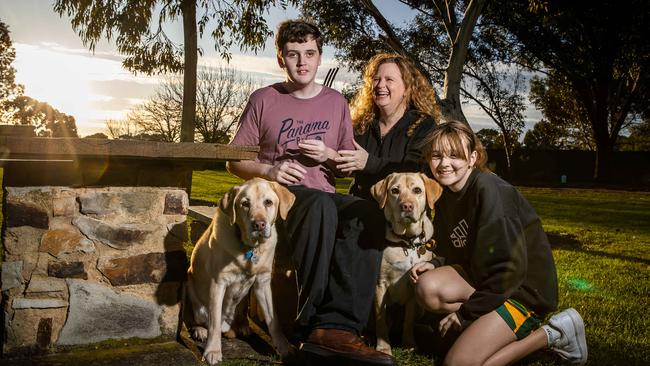
Guiding lights
Not every dog makes it as a traditional Guide Dog. “If you have 10 dogs and three to four dogs of them are good enough to be a Guide Dog (for the vision impaired) though, you’re doing well,” says Aaron Chia, CEO of Guide Dogs SA/NT.
“What we’re asking now is how many of those dogs are actually still suitable for a different role?”
For about a decade Guide Dogs has been running its autism assistance program in SA.
“It’s a very niche market but a very needed market because when you’re dealing with kids with autism, it’s not really just the child that gets the benefit from the dog,” Chia says.
“It’s really, you know, the parents, the family around them to be able to do things, like go to football games or the supermarket; being able to create that space for parents to be able to do that.”
However this program has traditionally been targeted at children aged 3-9 with severe autism.
Billy is their first pilot for a child over the age of eight.
“We’re so proud of what’s going on and the progress that has been made,” he says.
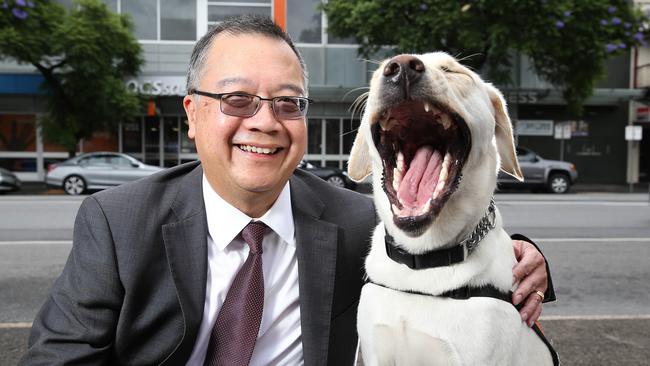
Keeping Billy safe
Tania remembers all too vividly the nightmare of taking Billy outside the house.
She would have to anchor him to herself with a strap, but often even this was not enough.
“Billy, when he was little, had no idea of personal safety or boundaries,” she says.
“He’d just shoot off when he got heightened or stressed.
“He’d just run.
“He had a thing about lifts and balconies of all things; like peering over the top of balconies. It didn’t matter how high up it was.
“And it got worse the bigger he got (he’s now about 190cm).” Shopping centres were particularly difficult. The crowds, the lights and the noise would often give Billy sensory overload and he would go into meltdown.
These aren’t uncommon for people with autism spectrum. While it is a spectrum condition, meaning it ranges (often dramatically) in severity, there are some common traits, such as difficulty forming social connections, problems with communication and being highly sensitive to external stimuli, like noise, lights and crowds.
“He would cry from the moment we entered the shopping centre, block his ears, and just cry the whole time until we got back in the car,” Tania says.
One time she had to leave her daughter, Laura, eight months of age at the time, with a total stranger at Tea Tree Plaza to chase after Billy.
Then there was a particularly harrowing experience on a busy city road.
“We were at OT (occupational therapy) and he literally ran on to the road at North Adelaide,” she recalls, slowly shaking her head.
“It was four lanes of traffic and I was holding my baby on my hip and going to the cars, ‘stop, stop’.
I knew then something had to be done. I couldn’t keep him safe.”
Tania had already spent months trawling the internet for ideas for help and came across the Guide Dogs SA/NT and its assistance dogs program. She was placed on a waiting list.
After the North Adelaide incident she contacted them again.
“I just said I know I put my application in but I really need help; something has to be done,” she says. So arrived River.
She noticed an almost immediate change in her son.
“Billy would always walk with his shoulders kind of hunched, but as soon as we hooked Billy up with River, his shoulders went back, and his chest pumped out, and his head went up,” she says.
“He’d pick up the leash and just start walking with him.
“It did everything for his confidence.
“He was very proud of himself.
“Billy never really liked animals, but with River it was instant. It was just meant to be.”
As the years went on, the changes to Billy’s behaviour were remarkable.
He stopped running.
The supermarket meltdowns stopped, too.
He became much, much calmer.
He could go shopping.
Visits to places like the Royal Show became a possibility.
He could take in a movie. Go out for a meal.
Appointments with the doctor and dentist were no longer an unbearable ordeal.
Then came the holidays.
All things that, only the blink of an eye ago, had seemed almost laughably remote.
“As soon as he got the dog it was like, ‘I can manage this’,” Tania says. “He’s much more calm and happy, not as stressed.
“I can’t say much for other animals but I love dogs and I think they’re so accepting. And they don’t see disability.
“When they’re together it’s like, ‘Hey mate, we’ve got this, you know, we’re a team’. He went with us on the plane to the Gold Coast.”
Such has been the progress that relatively new companion Ringer is less about safety and more about inclusion and independence.
“They walk together, they go out together. It’s a big, big progression from where we were,” she says.
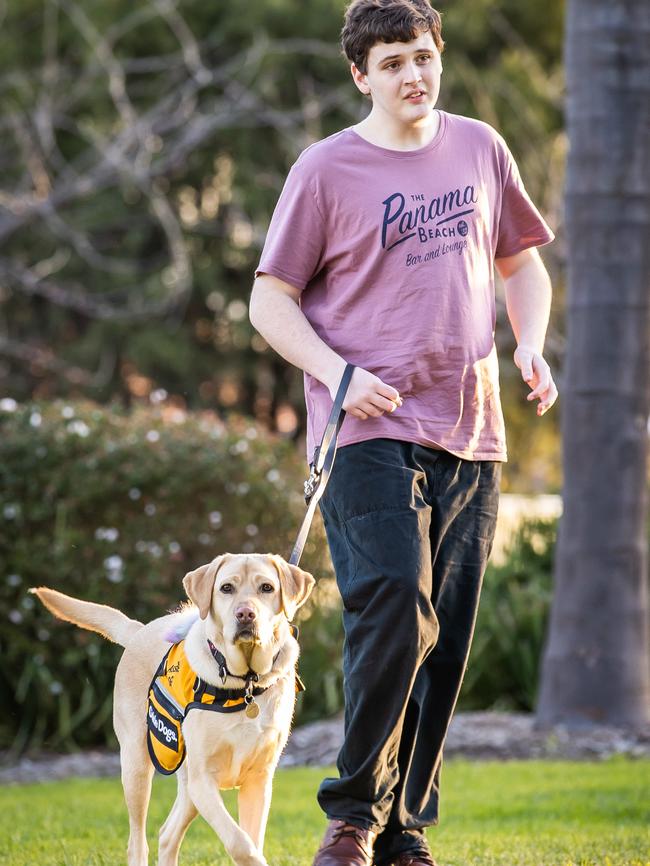
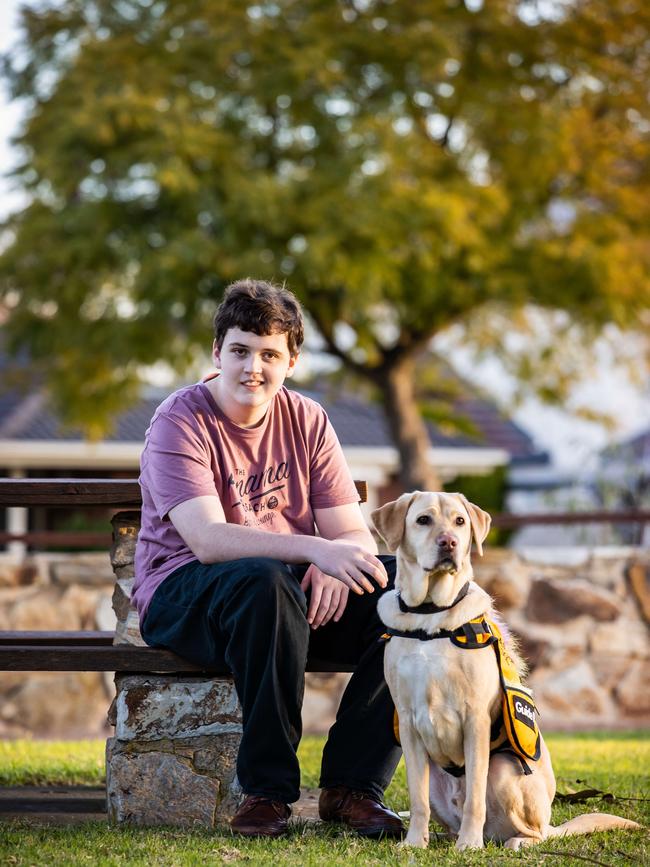
He also helps Billy cope with his regular seizures, and alerts the family when one is coming on; his tail goes straight and he looks frantically from Tania to Billy.
“If he doesn’t think I’m doing enough he’ll start barking at me,” Tania says with a smile.
“I calm him down by saying ‘it’s OK, Ringer’.
“He’ll sit on his legs and won’t move until Billy regains consciousness.”
Tania shudders to think what would have happened not just to Billy but her family if they had not come across River or Ringer. A full-time teacher, she is sure she would’ve had to give up work. She worries about the impact on Laura.
Most of all though, the relationship allows Billy to be a 17-year-old kid and at least do some of things a lot of 17-year-old kids would likely take for granted.
The afternoon we meet, he has returned from a visit to Bounce. The next day he will go for a swim at the Adelaide Aquatic Centre, in North Adelaide.
“We never pictured that we would have an assistance dog at 17 heading into adulthood to help him guide through life,” Tania says.
“The fact that he went from running like a lunatic through the shops and not coming back, needing an anchor strap to act as a weight.
“And now we don’t need that. That’s amazing. It’s just an amazing phenomenon.
“It’s something that I couldn’t have achieved without the dog.
“It’s given him independence I could never have given him. It makes him feel safe.
“The dog has given him purpose.”
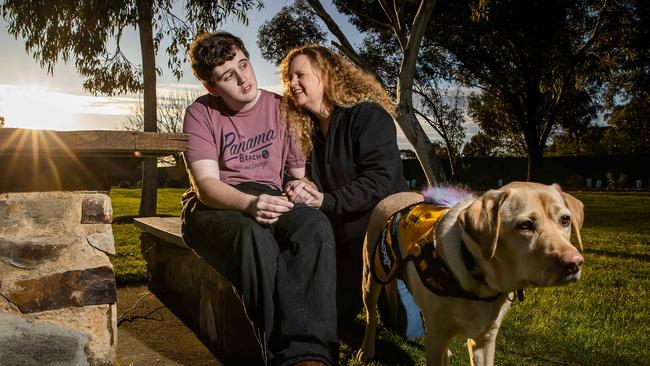
Calming influence
Chia says first and foremost the dogs have a calming influence on people. He sees it in Billy’s case and in other programs where assistance dogs have been used, such as at special schools, in the judicial system and at Adelaide Airport.
“I think scientifically it’s been proven that when the dog is a companion, the brain releases certain chemicals that actually just calm you. That’s what happens,” he says.
“We’ve had some pilots where we’ve had dogs at special schools, where a dog goes in there and it has a calming effect on the kids, which really helps the teachers.”
Around the city’s court system, Zero was the gold standard. The big, black labrador, who died earlier this year from cancer, supported more than 300 vulnerable witnesses and victims of crime.
Then there’s Elmo, who this year started as an assistance dog at Adelaide Airport, providing comfort to nervous flyers and those with special needs.
“This lady wrote to us with so much gratitude saying that she had three kids with her and one of the kids was on the (autism) spectrum,” he says.
“It was just a crazy day because it was so busy, it was post-Covid and everything, and the child was finding it really difficult.
“So she was crying, finding it really hard to control him and then they’re on the lookout for their two other kids.
“Then suddenly, ‘Oh my, the airport dog is out there’.
“The son just went quiet. They sat down with Elmo and he settled down.
“And she wrote us the most wonderful letter thanking us, saying everyone in the plane should thank us because it would have been a disaster if he had gone off on the plane.”
Chia loves stories like this; they make him want to continue to expand the program.
“You know one of the founding principles of Guide Dogs is that everyone that needs a guide dog gets one,” he says.
“My aim is that no one falls through the cracks.”
The biggest hurdle is funding; it costs, on average $50,000 to train each dog.
Hence the association is embarking on its main fundraising drive for the year, aptly titled PAWGUST, in an effort to try and bridge some of this gap.
Super smart
Billy is back on the iPad.
It’s how he best communicates.
A lot of parents of children on the autism spectrum will tell you their child understands what you are saying or asking, but simply struggles to verbalise a response.
Billy is a case in point. His communication is clear and concise on the device, and he responds to questions in an instant. He is, as his mum succinctly puts it, “super smart”.
Tania says the penny dropped during an extended stay in hospital; Billy was answering complicated maths questions almost automatically.
“I asked him how and he typed out, ‘Boy next to me have a chart at school’,” she says.
“So I talked to his teacher as he said, ‘Oh you’re talking about Daniel; Daniel likes numbers. And he had a chart where you trace it, like seven by seven equals 49, and Billy memorised the chart.
“So I was like, ‘Oh my god. So if you can read numbers, can you read words?”
He could.
From that realisation, his communication skills blossomed and a new world opened up for mum and son.
Asked today why Ringer helps him so much, he says: “Because he gives me space to move in busy places.”
Or, as Tania puts it, helps him find his way through an often difficult and complicated world.
